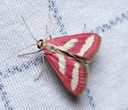Odontiinae
Odontiinae
Classification
- Phylum: Arthropoda
- Subphylum: Hexapoda
- Class: Insecta
- Order: Lepidoptera
- Superfamily: Pyraloidea
- Family: Crambidae
- Subfamily: Odontiinae
Pronunciation
How to pronounce Odontiinae: /oʊˈdɒntɪˌaɪniː/
These audio files are automatically generated. While they are not always 100% accurate, they are a good starting point.
Images






Summary
The Odontiinae represents a diverse subfamily of moths characterized by unique morphological traits in males and diverse feeding habits among larvae. The group features a significant number of genera and species, particularly adapted to specific habitats.
Physical Characteristics
Male odontiines exhibit a semi-membraneous uncus that is broad and bilobed at the end, while the valva is rounded at the apex.
Identification Tips
Distinguish this subfamily by examining male genitalia which show the unique bilobed uncus and rounded valva.
Habitat
Odontiinae moths are most commonly found in eremic habitats, characterized by sparsely vegetated regions.
Distribution
Primarily known from the Nearctic region, they exhibit diversity across several habitats.
Diet
The larvae of Odontiini typically feed as leaf miners on a variety of host plants, mainly Dicotyledonae, while Eurhypiini larvae may engage in leaf folding, flowering, bud feeding, and stem boring.
Life Cycle
Detailed lifecycle information is sparse; however, larvae undergo metamorphosis typically associated with lepidopterans.
Reproduction
Reproductive strategies are not well-documented; likely similar to other moths involving oviposition on host plants.
Ecosystem Role
Larvae interact with plant communities primarily as herbivores, potentially influencing plant health and diversity.
Collecting Methods
- Light trapping
- Netting during diurnal activity
Preservation Methods
- Pinning
- Freezing prior to storage
Evolution
Odontiinae represents an extreme case of generic splitting among Nearctic Lepidoptera, indicating complex evolutionary relationships.
Tags
- Lepidoptera
- Crambidae
- Odontiinae
- Moths
- Eremic habitats